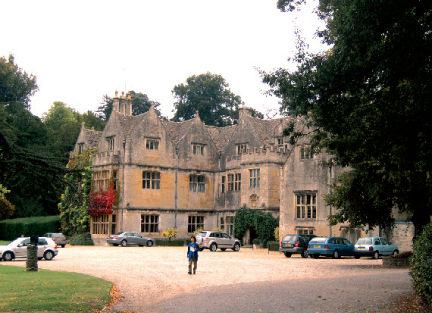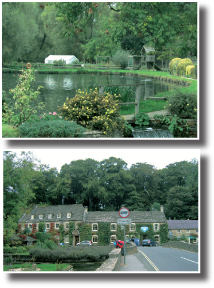
The Cotswolds
Text and Pix by Nilma Dole
I held my breath as I came
face-to-face with a wooly sheep suckling her new-born lamb with the
beautiful backdrop of the Cotswolds in full view.
 I’ve never seen real woolen sheep before (only black sheep of
families) and here I was in the company of many! The stunning views of
rolling meadows and lush fields with cute sheep look like cotton candy
dotted on a cake hill of green icing. I’ve never seen real woolen sheep before (only black sheep of
families) and here I was in the company of many! The stunning views of
rolling meadows and lush fields with cute sheep look like cotton candy
dotted on a cake hill of green icing.
The Cotswolds range are hilly plains in west-central England fondly
referred to as the “Heart of England”, an area 25 miles (40 km) across
and 90 miles (145 km) long. The area has been designated as the
Cotswolds Area of Outstanding Natural Beauty. The highest point in the
Cotswolds range is Cleeve Hill at 1,083 ft (330 m), 2.5 miles (4 km) to
the north of Cheltenham. The name Cotswold means either “sheep enclosure
in rolling hillsides” or it was coined from the term “wold” meaning
hills.
As I happened to glance at the beauty of the Cotswolds just near the
town of Stroud, I was happy to know that they not only stretch across
the ceremonial counties of Gloucestershire and Oxfordshire, but extend
into parts of Wiltshire, Somerset, Worcestershire and Warwickshire.
The Cotswolds was declared as an Area of Outstanding Natural Beauty (AONB)
in 1966, with an expansion on December, 21 1990 to 1,990 square
kilometres. In 1991, as all AONBs were measured again using modern
methods, the official area of the Cotswolds AONB increased to 2,038
square kilometres. In 2000, the government confirmed that AONBs had the
same landscape quality and status as National Parks.
 The Cotswolds Conservation Board is the organisation that exists to
conserve and enhance the AONB. In the Middle Ages, the wool trade made
the Cotswolds prosperous; hence the Speaker of the British House of
Lords sits on the Woolsack showing where the Medieval wealth of the
country came from. Some of this money was put into the building of
churches so the area has a number of large, handsome Cotswold stone
“wool churches”. The area remains affluent and has attracted wealthy
people who own second homes in the area or have chosen to retire to the
Cotswolds. The Cotswolds Conservation Board is the organisation that exists to
conserve and enhance the AONB. In the Middle Ages, the wool trade made
the Cotswolds prosperous; hence the Speaker of the British House of
Lords sits on the Woolsack showing where the Medieval wealth of the
country came from. Some of this money was put into the building of
churches so the area has a number of large, handsome Cotswold stone
“wool churches”. The area remains affluent and has attracted wealthy
people who own second homes in the area or have chosen to retire to the
Cotswolds.
As it inspired this writer to delve on creative aspects, the
Cotswolds has inspired some of England’s finest composers. In the early
1900s, Herbert Howells and Ivor Gurney used to go for long walks
together over the hills and Gurney urged Howells to make the landscape,
including the nearby Malvern Hills, the inspiration for his future work.
True to his word, in 1916, Howells wrote his first major piece, the
Piano Quartet in A minor, inspired by the magnificent view of the
Malverns - it was dedicated to “the hill at Chosen (Churchdown) and Ivor
Gurney who knows it”. Another contemporary of theirs, Gerald Finzi,
lived in nearby Painswick.
So life with the fresh air and quiet sheep doesn’t make you smile
sheepishly but gladdens your heart with the beauty of the Cotswolds. |

